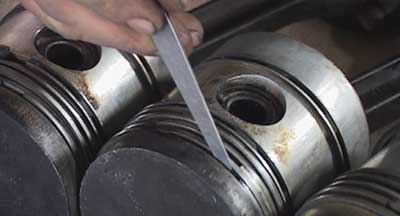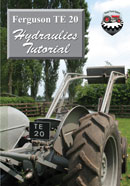Want to check out our tractor maintenance videos? Click here to see what we've got!
First thing is probably to inspect drive belt and see if it is OK for tension and condition.
Check that dynamo and control box are connected correctly. The larger dynamo terminal must be connected to control box terminal ‘D’. The smaller dynamo terminal connects to control box terminal ‘F’. Check the earth connection to the control box, terminal ‘E’. Check that the brown wire between the starter motor and the dashboard ammeter is intact. Check that the brown/yellow wire between the ameter and the regulator box is intact. Also that the dashboard ammeter shows a discharge when a 12 volt light bulb is lit using the brown/yellow wire which goes to the regulator box.
See this page for MF35 wiring diagram.
Switch off all lights and electricl accesories, disconnect the terminals from the dynamo. Start the engine and run on tick-over. Connect a volt meter from terminal ‘D’ to terminal ‘F’ (on the dynamo) and speed up the engine revs. The volt meter should read between 2 and 4 volts. If you get a zero reading then check that the brushes are free. If you still get a zero reading then it is the armature that is at fault.
Leave volt meter as above. Then also connect an amp meter from terminal ‘D’ to terminal ‘F’, increase the engine speed slowly and the voltage should rise with increased speed. Adjust the volt meter (by using the engine revs) to read exactly 12 volts, then the ameter should read 20A. If the volt meter reads 2 to 4 volts then this indicates a broken field (electric magnet is not working correctly). If you get 12 volts, but only 4 amps then this indicates an earth field (short circuit).
Excessive sparking at the commutator in the above test indicates a defective armature which should be replaced.
If you pass all of these tests for the dynamo then it may be the regulator box which is at fault. The regulator box is quite cheap to buy if this is the problem.






HELP, I have a 1961 MF 35 with the 3 cylinder Perkins. Unlike the control box diagram This tractor has a voltage regulator. Your diagram did not help. The regulator has a terminal labeled “BAT,” one labeled “F” one is labeled “L” there is also a terminal on the bottom of the regulator with no label however the one I removed has 4M, 12V & P/N stamped beside it. The removed regulators “F” terminal & bottom terminal was connected to the Dynamo the “BAT” terminal I believe was connected to a wire that went to a gauge. and the “L” terminal not connected. Can ;you tell me the proper way to wire the regulator.
I’m desperate
Phil
Hai,
I am pavan sai, studying final year eee in INDIA ,AP
1) How much speed is required to generate power in tractor dynamo ?
2) If speed is varies, is their any problem to generate electric power?
3) Is it work for any prime mover(i would like to rotate this shaft by using mechanical worm gears with different speed levels) ?
Hi Etienne,
‘run on tick-over’ means that the engine is on idling revs, or low engine spee, or that the engine revs showing on the tractometer is approximately 900 revolutions per minute.
Hope you can understand that.
Regards,
Steve.
Hello,what means “run on tick-over”?
I am from belgium and my english is not so good,excuse me.
Greats Etienne
[…] Testing a 12V Dynamo […]
Hi
Just reading about how to test a dynamo on a 35 could i use the same test on my TED 20 tvo trator
Cheers
Hello
Can anyone tell me where I can get a kit to convert out massey 165 from dynamo to alternator
Thanks